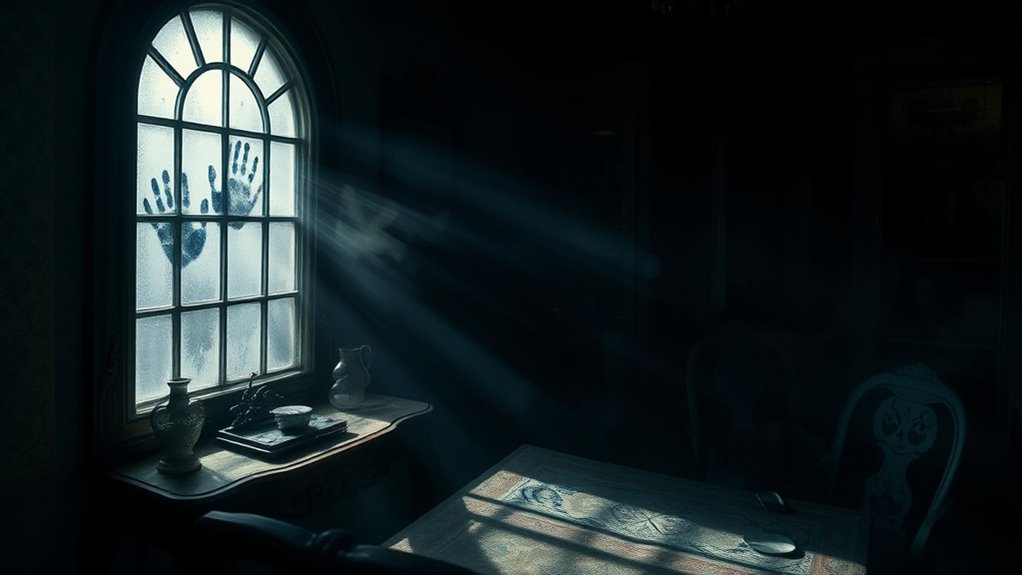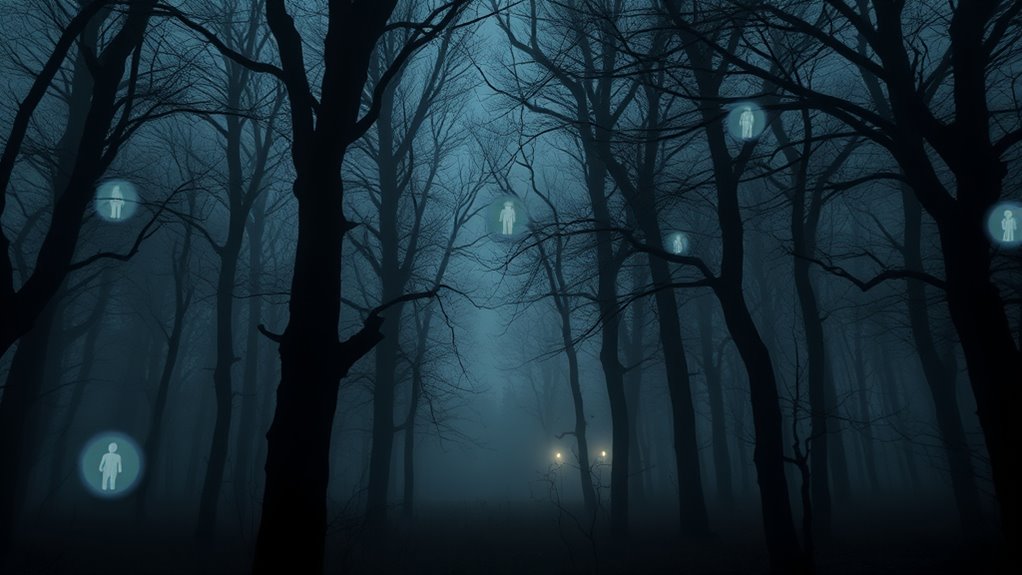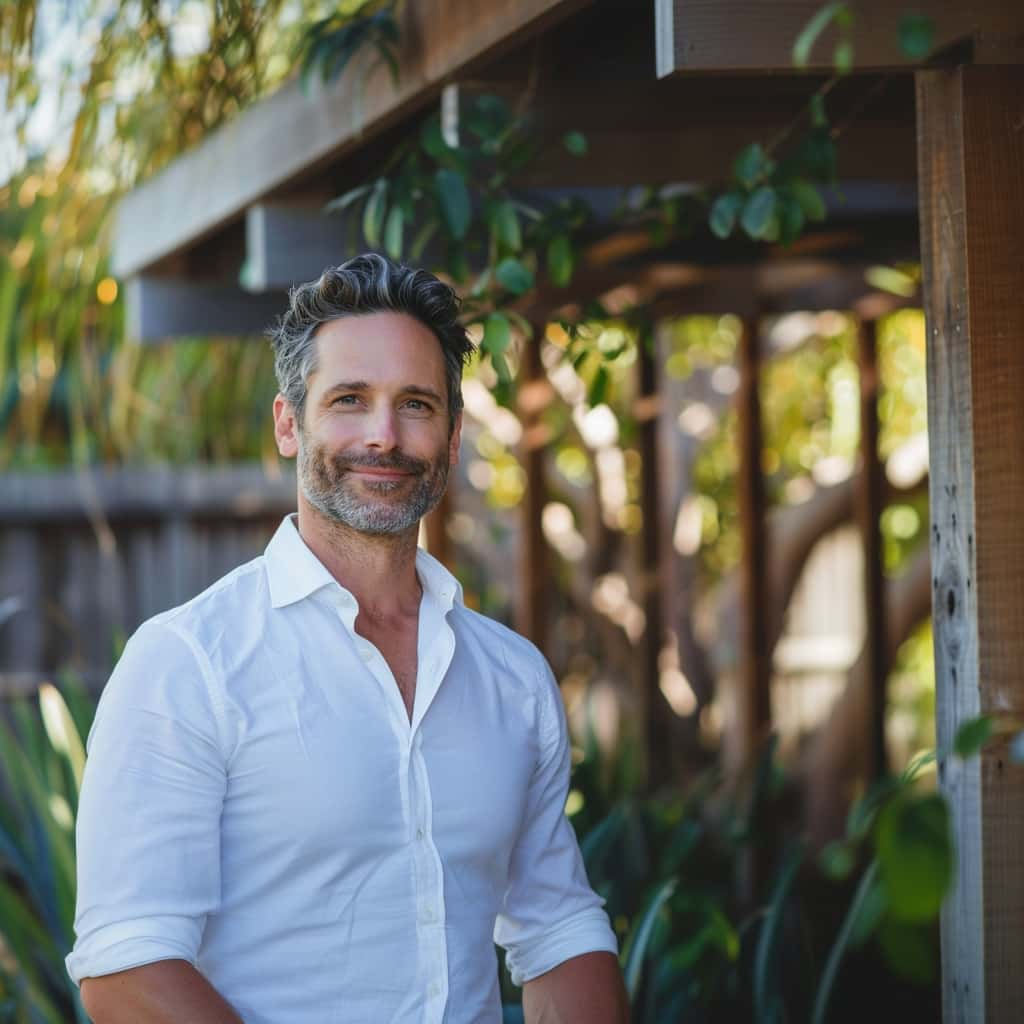Paranormal experiences cover a variety of phenomena, like ghosts and apparitions that appear suddenly, or strange noises with no clear source. Some report telepathy or out-of-body journeys, while others witness cryptid sightings like Bigfoot or Loch Ness. Poltergeist activities include objects moving on their own, and spirit communication often involves table tipping. Each of these experiences has different explanations, ranging from psychological to environmental factors. If you keep exploring, you’ll uncover even more intriguing insights behind these mysteries.
Key Takeaways
- Paranormal experiences include sightings of ghosts, apparitions, unexplained noises, cryptids, and mystical creatures.
- Consciousness-related phenomena encompass telepathy, mind perception, and near-death or out-of-body experiences.
- Poltergeist activity involves objects moving, strange noises, and physical sensations often linked to emotional or environmental factors.
- Scientific investigation and skepticism surround many phenomena, with explanations ranging from psychological to environmental causes.
- Personal accounts and cultural narratives enrich understanding but require critical evaluation for a balanced overview.
Ghosts and Apparitions

Many people claim to have seen ghosts or apparitions, often describing them as fleeting, transparent figures that appear suddenly and vanish just as quickly. You might notice a vague silhouette in a dimly lit room or see a shadowy figure out of your peripheral vision. These sightings tend to happen in familiar places like homes or historic sites. Often, you feel a strange presence or an inexplicable chill when encountering these apparitions. Despite their fleeting nature, many believe these visions are spirits trying to communicate or remind us of their existence. Some sightings are dismissed as tricks of the mind or optical illusions, but for others, these encounters leave lasting impressions and unanswered questions about the afterlife. Understanding paranormal phenomena can help shed light on why these experiences occur, including the role of dream symbols that may manifest during such encounters. Recognizing the psychological factors behind these visions can also provide a more balanced perspective on these mysterious experiences. Additionally, exploring cultural myths related to spirits can deepen our understanding of how these encounters are perceived across different societies. Furthermore, scientific investigations into paranormal experiences aim to identify natural explanations for sightings and encounters, fostering a more comprehensive view of these phenomena.
Unexplained Noises and Sounds

After observing fleeting apparitions, you might find yourself startled by strange sounds that defy explanation. These noises often come unexpectedly—knocks, tapping, or unexplained rustling that seem out of place. You might hear footsteps when no one is around or distant voices whispering softly. Sometimes, the sounds are rhythmic, like knocking on walls or doors, creating a sense of anticipation or unease. These noises can occur during quiet nights or in familiar environments, making them even more unsettling. While many attribute them to natural causes, such as structural settling or drafts, the timing and nature of these sounds often suggest something beyond ordinary explanation. They can leave you questioning whether you’re alone or if something unseen is trying to communicate. Unexplained noises may sometimes be linked to residual energies or phenomena that are still being studied by experts. Additionally, understanding the contrast ratio of your environment can influence how these sounds are perceived, especially in dark or quiet settings. The frequency of such noises can vary widely, adding complexity to their interpretation. Recognizing the cultural narratives surrounding paranormal sounds can also shape how individuals interpret these auditory experiences. Exploring the scientific investigations into such phenomena helps provide a clearer understanding of their possible origins and the factors that influence perception.
Telepathy and Mind Phenomena

Many people claim to experience telepathy and mind phenomena, but the evidence remains controversial. Scientific scrutiny questions whether these experiences are real or just coincidences, sparking ongoing debate. Personal accounts, however, continue to fuel curiosity about what the mind might truly be capable of. Some researchers explore the potential of electric mind devices to better understand these phenomena, which may influence the development of new aura visualization techniques. Recent studies also investigate the role of brainwave patterns in mediating such experiences, opening new avenues for scientific inquiry. Additionally, understanding relationship dynamics can shed light on how emotional states influence perceptions of paranormal activity. Moreover, the legalities surrounding tiny house regulations and zoning laws can significantly impact the feasibility of constructing or placing tiny homes in various regions.
Evidence and Scientific Scrutiny
Scientific scrutiny of telepathy and mind phenomena remains a contentious area, with researchers seeking concrete evidence to validate claims that thoughts can be transmitted directly between individuals. Despite numerous studies, consistent, replicable results remain elusive, fueling skepticism. Some experiments suggest intriguing correlations, but critics argue these findings lack robustness. The uncertainty can evoke feelings of hope and frustration, as you wonder if genuine connections are possible or just illusions. Consider the following: Research methodologies can significantly impact the credibility of findings in this field. Additionally, the rigor of experimental design plays a crucial role in determining the validity of results obtained in this challenging domain. Furthermore, the scientific community’s skepticism often hampers the acceptance of positive findings, emphasizing the need for more rigorous, transparent research. Advances in AI security could potentially help develop more reliable tools for studying such phenomena by ensuring data integrity and reducing biases. Incorporating standardized testing procedures can also improve consistency across different studies, fostering a clearer understanding of these complex phenomena.
Personal Accounts and Experiences
Have you ever felt a sudden sense that someone you care about is thinking of you, even without any apparent connection? Many people report experiences like this, attributing them to telepathy or mind-to-mind communication. These personal accounts often involve a strong intuition or a vivid thought that seems to come from nowhere. Sometimes, you might even dream about someone, only for them to contact you shortly afterward. While skeptics argue these are coincidences or the mind’s pattern recognition, believers see them as evidence of a deeper, unseen connection. These stories are powerful because they come from personal, emotional experiences. They remind us that, whether scientifically proven or not, such moments can feel profoundly real and meaningful to those who experience them. Additionally, AI-driven insights and algorithms are increasingly analyzing such phenomena to better understand mind phenomena and their potential explanations.
Near-Death and Out-of-Body Experiences

Near-death and out-of-body experiences often challenge our understanding of consciousness and reality. During these moments, you might feel as if you’re floating above your body or observing your surroundings from a detached perspective. Many report vivid, detailed visions or encounters with loved ones, suggesting a consciousness that persists beyond physical death. Researchers debate whether these experiences result from psychological, neurological, or spiritual factors. Some believe they offer glimpses into an afterlife, while others see them as brain-based phenomena triggered by trauma or lack of oxygen. Regardless of their origin, these experiences profoundly impact those who have them, often prompting questions about life, death, and what lies beyond. They remain one of the most intriguing and debated aspects of paranormal phenomena.
Poltergeist Activity

You might notice objects moving on their own or strange noises that can’t be explained. These are common signs of poltergeist activity, but understanding what causes them remains a challenge. Researchers explore possible explanations, from psychological factors to environmental influences, to make sense of these unsettling events.
Common Poltergeist Signs
Poltergeist activity often manifests through a series of unmistakable signs that can both intrigue and unsettle those nearby. You might notice objects moving on their own, seemingly without explanation. Unexplained noises, such as knocking, banging, or whispering, often fill the environment. Additionally, physical sensations like cold spots or sudden gusts of wind can signal activity.
These signs include:
- Objects being levitated or moved unexpectedly
- Sudden, unexplained loud noises or banging sounds
- Physical sensations like cold drafts or feeling touched without cause
Recognizing these signs can help you identify potential poltergeist activity. While unsettling, these indicators are some of the most common and recognizable signs associated with poltergeist phenomena.
Possible Explanations Explored
Many researchers and skeptics alike have proposed various explanations for poltergeist activity, aiming to understand these perplexing phenomena beyond supernatural causes. One widely considered theory suggests that stress or emotional turmoil can trigger physical disturbances, especially in adolescents or individuals under psychological strain. Some believe that subconscious acts, known as “auto-generated” phenomena, cause objects to move or break without conscious intent. Others point to environmental factors like drafts, structural issues, or electromagnetic interference that could produce sounds or movements mistaken for paranormal activity. While these explanations don’t account for every case, they highlight how psychological, physical, and environmental factors might contribute to poltergeist phenomena. This approach encourages a balanced view, blending scientific inquiry with open-mindedness.
Spirit Communication and Tables Tipping

Spirit communication through table tipping has long fascinated those seeking evidence of the paranormal. You might watch a table gently sway or tip in response to a spirit’s supposed message. This method relies on participants’ subconscious movements, often called the ideomotor effect, to produce movement. To understand this phenomenon better, consider:
- The historical roots in spiritualist movements of the 19th century, which popularized table tipping as a way to contact spirits.
- The psychological explanations, emphasizing how expectation and suggestion can influence movement without conscious awareness.
- The role of physical factors, such as the surface’s friction and participants’ hands, that can unintentionally cause the table to move.
While intriguing, these movements often have alternative explanations that challenge claims of genuine spirit communication.
Cryptid Sightings and Mystical Creatures

Have you ever wondered if mysterious creatures lurking in the shadows are real or just legends? Many believe sightings of cryptids like Bigfoot, the Loch Ness Monster, or the Chupacabra are evidence of unknown animals hiding from us. Eyewitness accounts often describe strange tracks, unusual sounds, or fleeting glimpses that challenge scientific explanation. Some researchers argue these sightings stem from misidentification or folklore, while others feel they point to undiscovered species. Mystical creatures also appear in stories and myths around the world, fueling curiosity and debate. Whether you see them as real or symbolic, these tales tap into our fascination with the unknown. Cryptid sightings remind us that the world still holds secrets waiting to be uncovered—or perhaps, just imagined.
Frequently Asked Questions
Can Paranormal Experiences Be Scientifically Proven or Measured Objectively?
You wonder if paranormal experiences can be scientifically proven or measured objectively. While many report personal encounters, science struggles to verify these claims due to a lack of consistent, measurable evidence. Most paranormal phenomena are subjective and influenced by individual perception, making objective proof difficult. Although some experiments attempt to study these experiences, they often haven’t produced conclusive, replicable results, so they remain outside the domain of scientific validation.
How Do Cultural Beliefs Influence Interpretations of Paranormal Phenomena?
Cultural beliefs serve as your personal compass, guiding how you interpret paranormal phenomena like a lighthouse piercing fog. If your culture whispers tales of spirits, you’re more likely to see supernatural signs in everyday shadows. These beliefs color your perceptions, turning ambiguous experiences into meaningful stories. Your background shapes your lens, making some phenomena seem like haunted echoes or divine messages, highlighting how deeply culture influences what you believe is paranormal.
Are There Common Psychological Explanations for Supposed Supernatural Encounters?
When you experience what seems like a supernatural encounter, your mind might be filling in gaps with familiar fears or memories. Common psychological explanations include sleep paralysis, which causes vivid hallucinations, and cognitive biases like pareidolia, where you see patterns or faces in random objects. Stress, fatigue, and suggestibility also play roles, making your brain interpret ambiguous stimuli as paranormal, even when natural explanations exist.
What Safety Precautions Should Individuals Take During Paranormal Investigations?
When you go on a paranormal investigation, you should prioritize safety. Always go with a group, share your plans, and carry reliable equipment like flashlights and first aid kits. Respect the environment, avoid risky areas, and stay sober to maintain clear judgment. Keep communication open, set boundaries, and trust your instincts. Remember, safety comes first to ensure a respectful and secure experience during your investigation.
How Do Age, Gender, or Personality Affect Susceptibility to Paranormal Experiences?
Perceptions, preferences, and personality play a part in how you experience the paranormal. Your age can influence your openness or skepticism, while gender might shape your sensitivity or fears. Personality traits, like curiosity or caution, also determine how you interpret mysterious moments. You’re more likely to notice and react to paranormal phenomena based on these factors, making your unique outlook a powerful part of your paranormal pathway.
Conclusion
Exploring these paranormal experiences is like wandering through a mysterious forest, each path revealing new wonders and questions. While some encounters feel like whispers from the unseen, others challenge your understanding of reality. Whether you believe or remain skeptical, keep an open mind, as these phenomena are the shadows and flickers that dance just beyond the edge of our understanding. Embrace the mystery, knowing that some secrets are meant to stay just out of reach.










